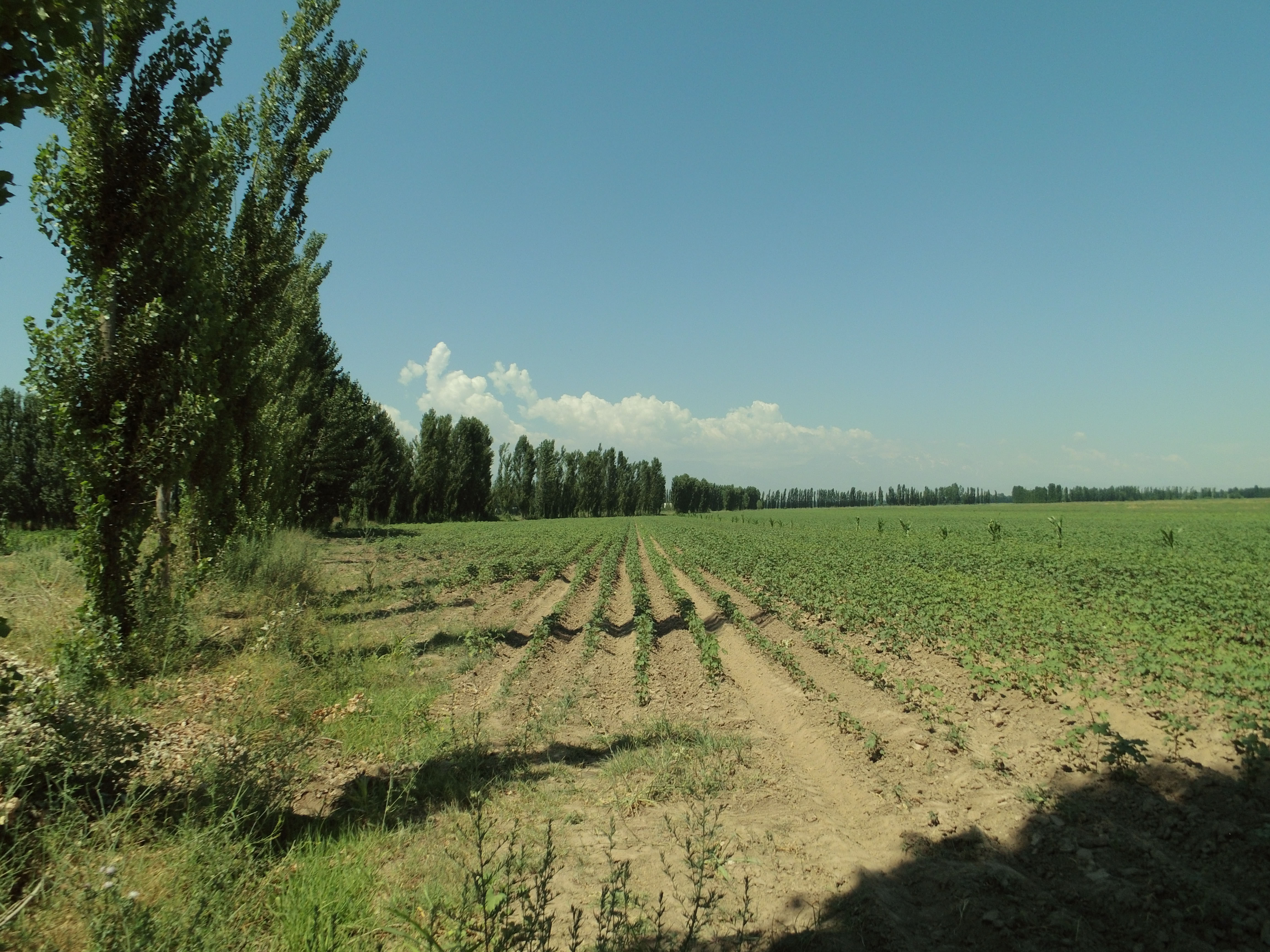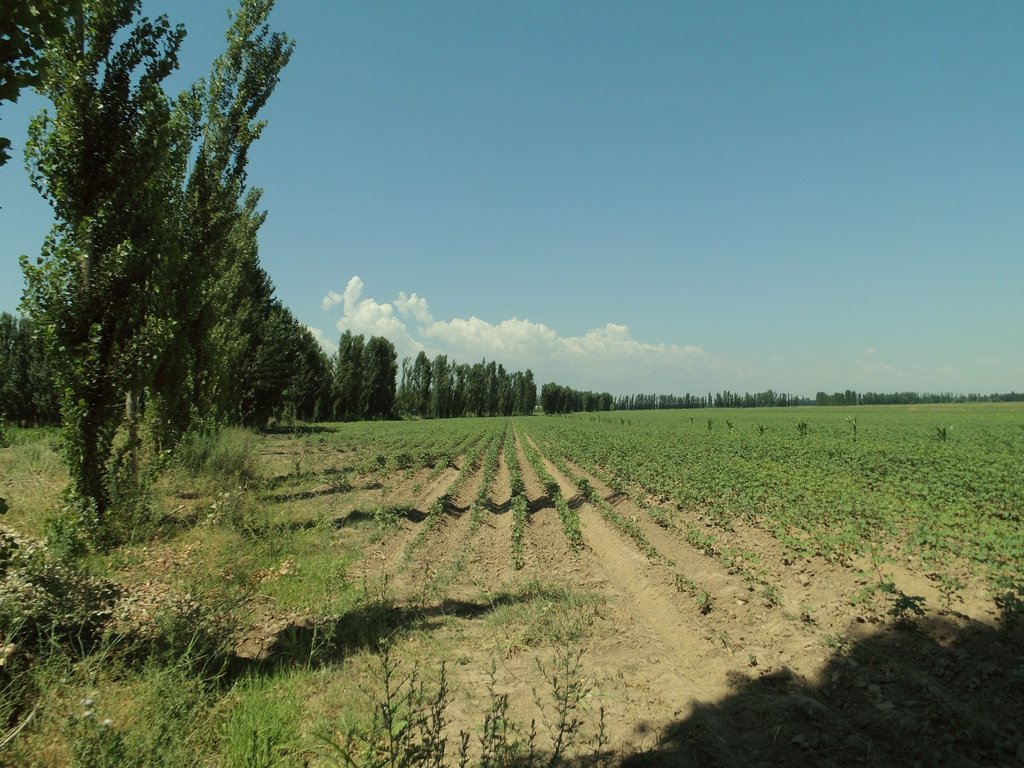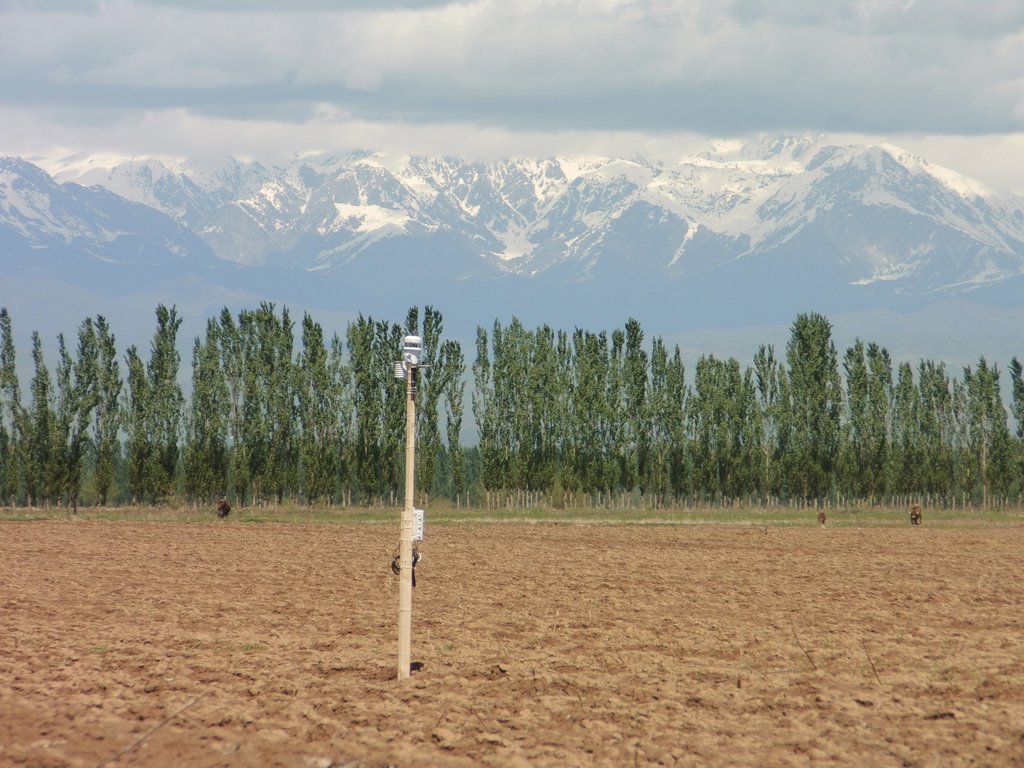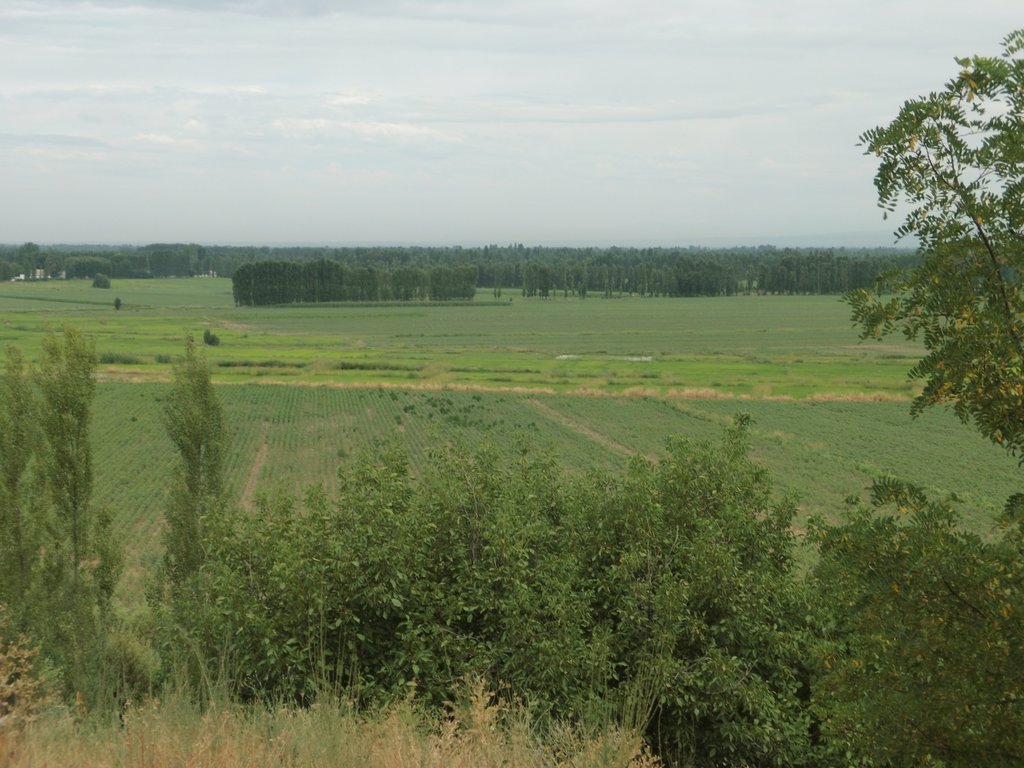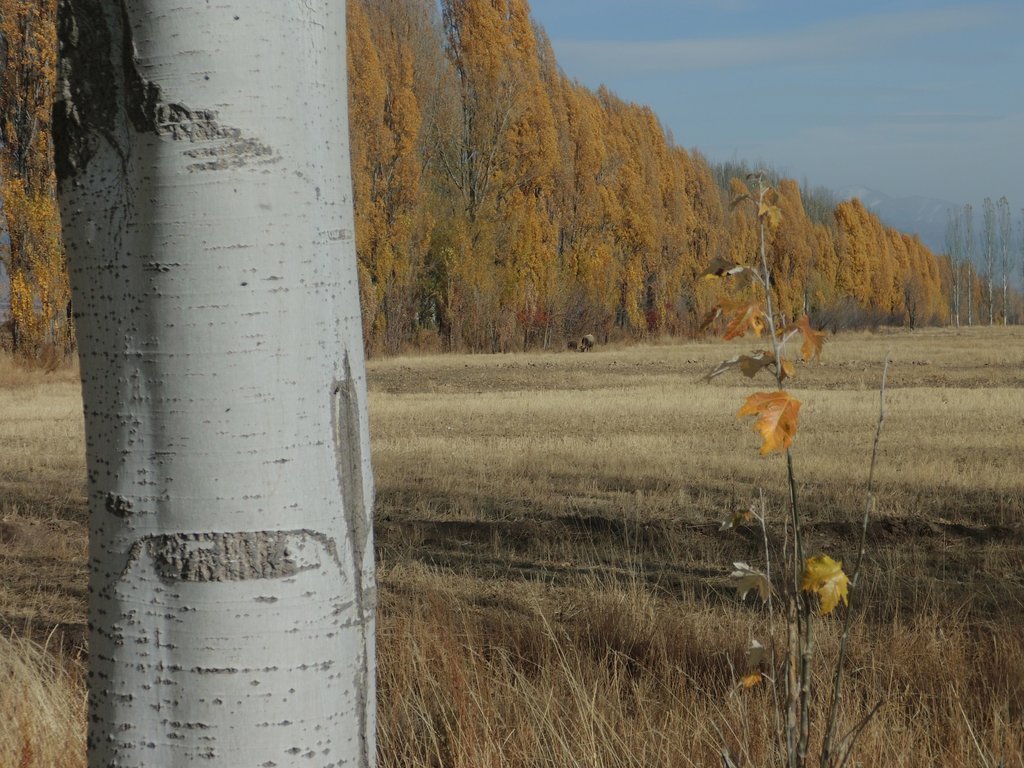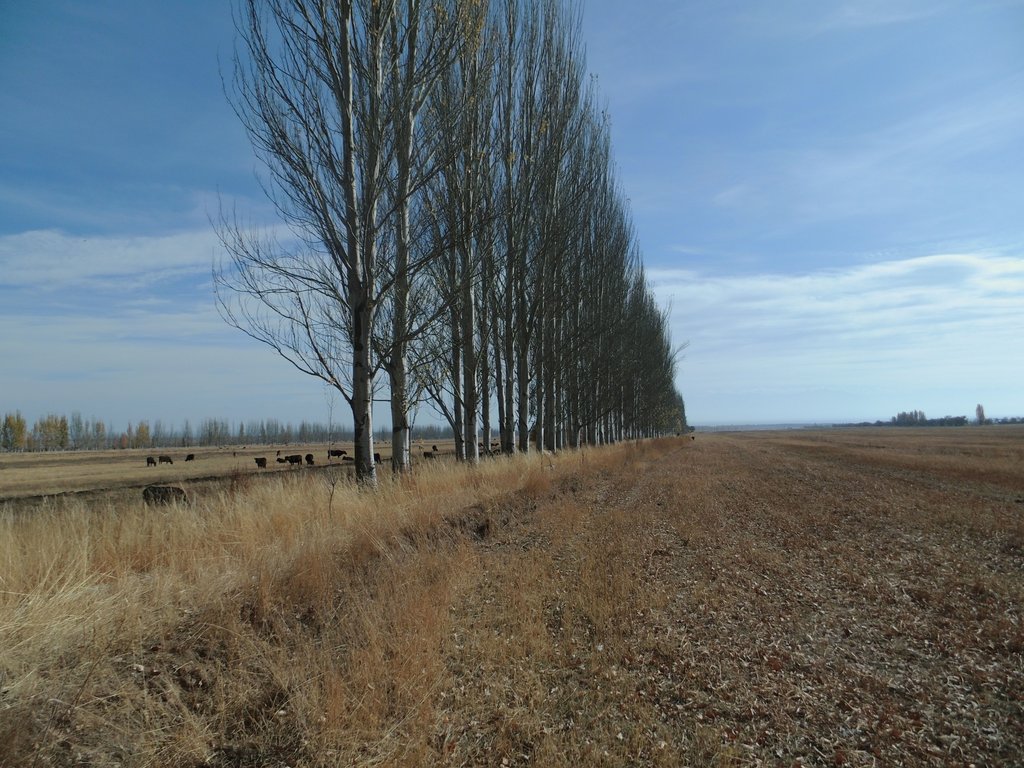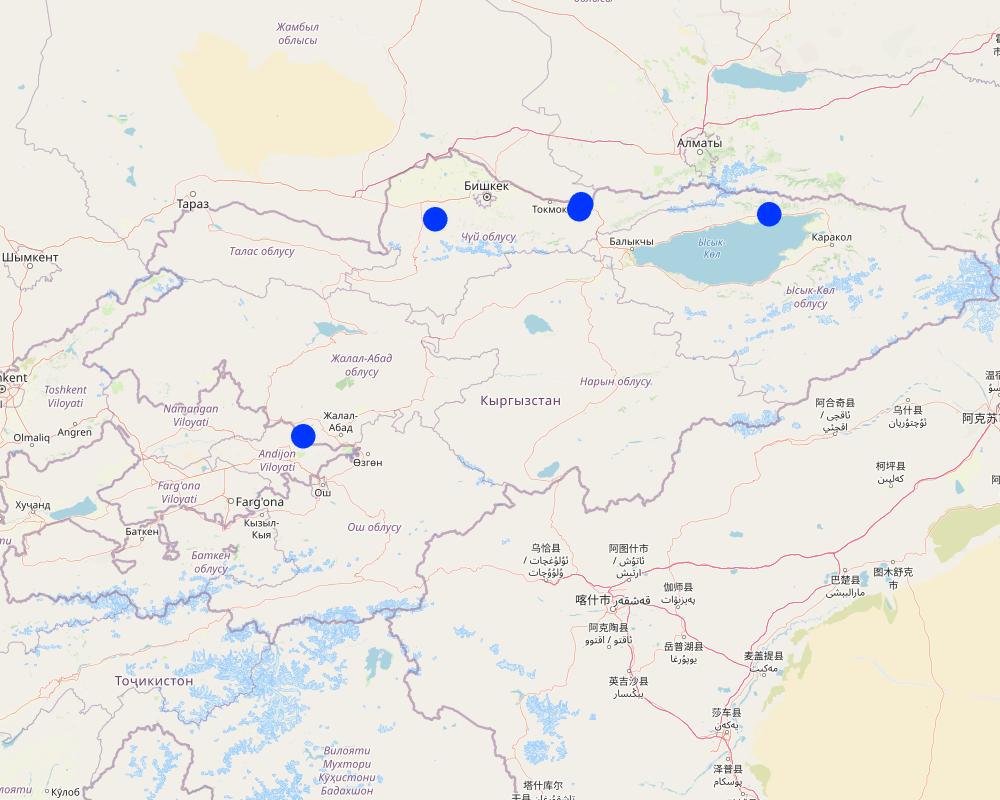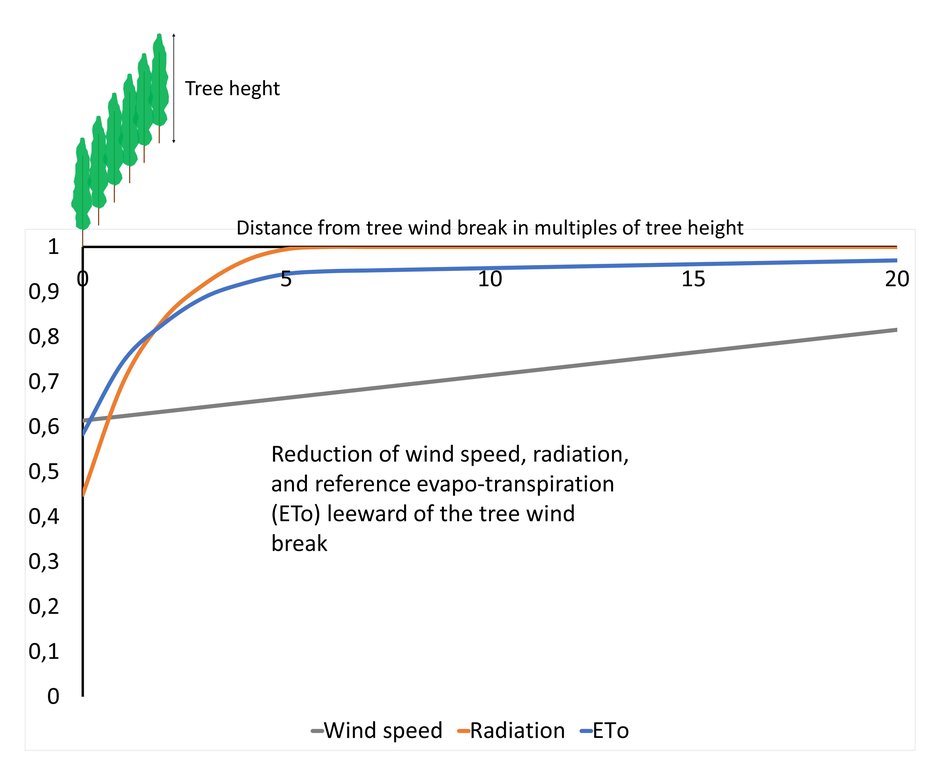Tree windbreaks within irrigated agriculture in Central Asia [Kyrgyzstan]
- Creation:
- Update:
- Compiler: Niels Thevs
- Editor: Hayot Ibrakhimov
- Reviewers: William Critchley, Rima Mekdaschi Studer
technologies_5861 - Kyrgyzstan
View sections
Expand all Collapse all1. General information
1.2 Contact details of resource persons and institutions involved in the assessment and documentation of the Technology
Name of the institution(s) which facilitated the documentation/ evaluation of the Technology (if relevant)
International Centre for Research in Agroforestry (ICRAF) - Kenya1.3 Conditions regarding the use of data documented through WOCAT
The compiler and key resource person(s) accept the conditions regarding the use of data documented through WOCAT:
Ja
1.4 Declaration on sustainability of the described Technology
Is the Technology described here problematic with regard to land degradation, so that it cannot be declared a sustainable land management technology?
Nee
1.5 Reference to Questionnaire(s) on SLM Approaches (documented using WOCAT)
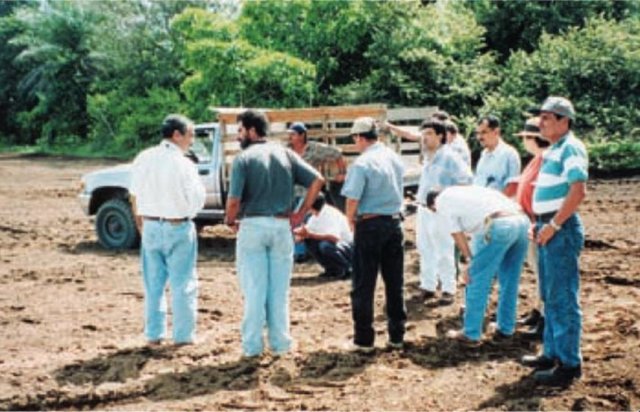
Agroforestry extension [Costa Rica]
Participatory extension of agroforestry systems, especially of shadegrown coffee, to promote sustainable and productive use of natural resources among small and medium scale farmers.
- Compiler: Olman Quiros Madrigal
2. Description of the SLM Technology
2.1 Short description of the Technology
Definition of the Technology:
Windbreaks of poplar trees (Populus nigra pyramidalis) are a major agroforestry system in irrigated agriculture across Central Asia. Such windbreaks reduce the overall water consumption of irrigated agriculture by 10-20% and increase farm income by 10-15%.
2.2 Detailed description of the Technology
Description:
Windbreaks of trees are a major agroforestry system across Central Asia. The SLM technology presented here concentrates on windbreaks, chiefly of poplar trees (Populus nigra var. pyramidalis), within irrigated agriculture. These windbreaks of poplars have a long tradition as an agroforestry system in irrigated agriculture in the river basins of south and southeastern Kazakhstan, Kyrgyzstan, Tajikistan, Turkmenistan, and Uzbekistan. In Kazakhstan and northern parts of Kyrgyzstan, poplars are partly replaced by Elm (Ulmus minor) windbreaks.
After those five countries had become independent, a large share of the windbreaks was cut down primarily for fuelwood and secondarily for timber, as the energy supply system had broken down in the course of the disintegration of the Soviet Union. Such windbreaks reduce the overall water consumption of irrigated agriculture by 10-20% compared to open field conditions, depending on crops and tree spacing (Thevs et al., 2019: doi:10.3390/land8110167). The trees serve as an additional source of income, chiefly from sustainable harvest of the trees for timber. Windbreaks also help to increase crop yields. In total, farm income is increased by 10-15% over the rotation period of the trees (Thevs and Aliev, 2021: https://doi.org/10.1007/s10457-021-00617-7). The rotation period of poplars is between 12 and 20 years, depending on the climatic conditions, e.g. poplars in the Ferghana Valles reach DBH (diametre at breast height) values of 22-27 cm and tree heights of 18 m after 13 years.
In this recent assessment, it was found that windbreaks of single tree rows with distances between trees of 1 m had the best effects on water saving and increasing farm income. The most suitable spacing between windbreaks was found to be around 200 m.
Windbreaks are perceived differently by land users depending on the region and knowledge (Ruppert et al., 2020: doi:10.3390/su12031093). For example, land users in the Ferghana Valley perceived windbreaks positively and were planting them primarily with the aim to have wood resources in the near future. In contrast, land users in the northern part of Kyrgyzstan were afraid firstly that windbreaks shaded their crops, consumed space, and competed for water and nutrients, and secondly that planting windbreaks may cause conflicts with neighbours due to those negative connotations. Farmers with larger field plots were more open towards them.
Windbreaks are planted with 2-year-old poplar saplings, which are locally available. The preferred place to plant is along irrigation ditches or other existing field boundaries. If windbreaks are planted along irrigation ditches, they simply tap water from the moist soil or elevated groundwater adjacent to those ditches. Otherwise, the trees need to be irrigated like the crops. As furrow irrigation is the dominant irrigation practice throughout Central Asia, poplars can be integrated without further adjustments in the field of irrigation. Alongside irrigation ditches poplars can withstand high water levels in those ditches as they occur during irrigation periods. If farmers switch to drip irrigation, and irrigation ditches are no longer present, the trees will need to be supplied with a dripline as well. The locally available poplar cultivars do not need additional fertilizer, but profit from the fertilizer applied to the crop. Only if high yielding modern cultivars were to be used, additional fertilizer application to the trees would be needed to unfold their full potential.
2.3 Photos of the Technology
2.4 Videos of the Technology
Comments, short description:
Video on Youtube: https://www.youtube.com/watch?v=2mAfQzO7MHg
This video provides a concise introduction into tree wind breaks, including their advantages with regards to water consumption, building resiliance against climate change, and income.
Date:
01/09/2019
Location:
Ferghana Valley, Kyrgyzstan
Name of videographer:
Gino Carlo Garcia
Comments, short description:
This video on Youtube, https://www.youtube.com/watch?v=Iv0VdPqBT9o, is part of a series on poplars. This part focusses on tree wind breaks with many statements of local acteurs. The other parts of this series introduce high yielding poplar cultivars and their options in agroforestry, woodlints, and value chains.
Date:
01/02/2020
Location:
Kyrgyzstan
Name of videographer:
Lea Gerster and Stefanie Breunlich
2.5 Country/ region/ locations where the Technology has been applied and which are covered by this assessment
Country:
Kyrgyzstan
Region/ State/ Province:
Jalalabad Region, Chui Region, and Issyk Kul Region
Specify the spread of the Technology:
- evenly spread over an area
If precise area is not known, indicate approximate area covered:
- 0.1-1 km2
Is/are the technology site(s) located in a permanently protected area?
Nee
Comments:
Windbreaks are spread over large areas, but the spatial distribution can be described as pockets of between 10 and 1000 ha. Within those pockets, tree wind breaks are sometimes interrupted. Also outside those pockets with more or less contiguous windbreaks systems there are remnants of those systems.
Map
×2.6 Date of implementation
If precise year is not known, indicate approximate date:
- 10-50 years ago
2.7 Introduction of the Technology
Specify how the Technology was introduced:
- as part of a traditional system (> 50 years)
3. Classification of the SLM Technology
3.1 Main purpose(s) of the Technology
- improve production
- adapt to climate change/ extremes and its impacts
- create beneficial economic impact
3.2 Current land use type(s) where the Technology is applied
Land use mixed within the same land unit:
Ja
Specify mixed land use (crops/ grazing/ trees):
- Agroforestry

Cropland
- Annual cropping
- Tree and shrub cropping
Annual cropping - Specify crops:
- fibre crops - cotton
- cereals - maize
- cereals - wheat (winter)
- cereals - wheat (spring)
- cereals - rice (wetland)
- cereals - barley
- fodder crops - alfalfa
- root/tuber crops - potatoes
- Poplars
Number of growing seasons per year:
- 1
Is intercropping practiced?
Nee
Is crop rotation practiced?
Nee
3.3 Has land use changed due to the implementation of the Technology?
Has land use changed due to the implementation of the Technology?
- No (Continue with question 3.4)
Land use mixed within the same land unit:
Ja
Specify mixed land use (crops/ grazing/ trees):
- Agroforestry
3.4 Water supply
Water supply for the land on which the Technology is applied:
- full irrigation
Comments:
As the spatial distribution stretches over large parts of Central Asia, some locations where windbreaks are planted are rainfed and irrigated, but most parts need full irrigation.
3.5 SLM group to which the Technology belongs
- agroforestry
- windbreak/ shelterbelt
3.6 SLM measures comprising the Technology

vegetative measures
- V1: Tree and shrub cover
3.7 Main types of land degradation addressed by the Technology

soil erosion by wind
- Et: loss of topsoil

water degradation
- Ha: aridification
- Hg: change in groundwater/aquifer level
Comments:
The main effect of windbreaks in the assessed areas is mainly reducing water consumption, and less wind erosion. Poplars could help to lower groundwater levels and thus contribute to combat salinization. But that did not play a role in the areas specifically assessed.
3.8 Prevention, reduction, or restoration of land degradation
Specify the goal of the Technology with regard to land degradation:
- reduce land degradation
4. Technical specifications, implementation activities, inputs, and costs
4.1 Technical drawing of the Technology
Technical specifications (related to technical drawing):
Windbreaks have their greatest impact when planted perpendicular to the main wind direction (or direction of the strongest winds). A whole grid of tree wind breaks running along all field plot borders will have a greater effect, as it prevents enhanced winds through a tunnel effect under changing wind directions. Tree wind breaks can be planted with distances of 50 m to 1000 m away from each other. The effect on the micro climate becomes less pronounced with increasing distance from tree wind breaks. Therefore, on a large field plot, say of 1000 m width between windbreaks, the micro climate averaged over the field plot will not differ much from the conditions without tree wind breaks. In contrast, on smaller field plots, say of 100 m width between windbreaks, the micro climate will differ significantly from open field conditions. This is also explained by the lines for temperature, air humidity, radiation, and in particular wind speed along an increasing distance from a given windbreak. Thereby, the distance from the windbreak is given in multiples of tree height.
In total, the best effects with regard to economic return and reduced water consumption come with a spacing of 200 m between tree wind breaks.
The best effects with regard to economic return and reduced water consumption were achieved with single tree lines. So, only one line of poplar trees is planted along the field borders. The planting distance between trees is 1 m to 1.20 m.
Poplar trees are locally available as trees with a length of 2 m to 2.50 m. Those trees are planted, best along the small irrigation ditches that run along the field borders. The local cultivar which is mainly used is a Populus nigra var. pyramidalis cultivar under the local name Mirza Terek. In principle, modern high yielding cultivars can be used as well; first research has shown a 2-3 times faster growth compared to the locally available cultivars at similar water and nutrient requirements.
Author:
Niels Thevs
Date:
25/03/2021
4.2 General information regarding the calculation of inputs and costs
Specify how costs and inputs were calculated:
- per Technology area
Indicate size and area unit:
1 ha
other/ national currency (specify):
KGS
If relevant, indicate exchange rate from USD to local currency (e.g. 1 USD = 79.9 Brazilian Real): 1 USD =:
68.87
Indicate average wage cost of hired labour per day:
750
4.3 Establishment activities
| Activity | Timing (season) | |
|---|---|---|
| 1. | Tree planting | March (first year) |
| 2. | Maintenance of trees | April to September (first and second year) |
| 3. | Harvest of trees | December to February (last year of tree rotation - after 15 years) |
Comments:
These entries refer to a windbreak system of poplars to be harvested at tree age of 15 years combined with cotton. Thereby, the activities related to trees, including the harvest, are considered as activities to establish windbreaks into an agrarian landscape where irrigated agriculture is ongoing. The annual crop related activities are therefore listed under maintenance. If cotton is rotated with corn or rice, the timing of the crop-related activities is similar.
4.4 Costs and inputs needed for establishment
| Specify input | Unit | Quantity | Costs per Unit | Total costs per input | % of costs borne by land users | |
|---|---|---|---|---|---|---|
| Labour | Labor costs for tree planting and maintenance (first year) | man-days | 3.0 | 750.0 | 2250.0 | 100.0 |
| Labour | Labor costs for tree maintenance (second year) | man-days | 3.0 | 650.0 | 1950.0 | 100.0 |
| Equipment | Labor costs to harvest trees (at tree age 15 years) | man-days | 3.0 | 70.0 | 210.0 | 100.0 |
| Plant material | Poplar saplings | sapling | 116.0 | 20.0 | 2320.0 | 100.0 |
| Plant material | Transport of saplings | 500.0 | 1.0 | 500.0 | 100.0 | |
| Total costs for establishment of the Technology | 7230.0 | |||||
| Total costs for establishment of the Technology in USD | 104.98 | |||||
Comments:
Costs had been retrieved for the year 2017. Costs that appear in the second year and later were discounted at a discount rate of 17.5% based on costs as of 2017.
4.5 Maintenance/ recurrent activities
| Activity | Timing/ frequency | |
|---|---|---|
| 1. | Soil preparation and sowing of annual crop (cotton) | March to April / every year |
| 2. | Irrigation, fertilizer application and other farm operations for the crop | April to August / every year |
| 3. | Harvest of the crop (cotton) | September to October / every year |
4.6 Costs and inputs needed for maintenance/ recurrent activities (per year)
| Specify input | Unit | Quantity | Costs per Unit | Total costs per input | % of costs borne by land users | |
|---|---|---|---|---|---|---|
| Labour | Labor costs for soil preparation | man-days | 6.81 | 750.0 | 5107.5 | 100.0 |
| Labour | Labor costs for sowing | man-days | 2.5 | 750.0 | 1875.0 | 100.0 |
| Equipment | Labor costs for irrigation | man-days | 23.64 | 750.0 | 17730.0 | 100.0 |
| Equipment | Labor costs to apply fertilizer and plant protection | man-days | 3.34 | 750.0 | 2505.0 | 100.0 |
| Equipment | Labor costs for harvest (cotton) | man-days | 32.78 | 554.0 | 18160.12 | 100.0 |
| Equipment | Machine costs (rent) for soil preparation | ha | 1.0 | 10021.0 | 10021.0 | 100.0 |
| Equipment | Machine costs (rent) for sowing | ha | 1.0 | 1316.0 | 1316.0 | 100.0 |
| Equipment | Machine costs for fertilizer application | ha | 1.0 | 1200.0 | 1200.0 | 100.0 |
| Plant material | Seeds | kg | 50.0 | 101.0 | 5050.0 | 100.0 |
| Fertilizers and biocides | Fertilizer | kg | 375.0 | 19.25 | 7218.75 | 100.0 |
| Fertilizers and biocides | Plant protection | ha | 1.0 | 1517.0 | 1517.0 | 100.0 |
| Other | Water fee | ha | 1.0 | 1014.0 | 1014.0 | 100.0 |
| Total costs for maintenance of the Technology | 72714.37 | |||||
| Total costs for maintenance of the Technology in USD | 1055.82 | |||||
4.7 Most important factors affecting the costs
Describe the most determinate factors affecting the costs:
Labour costs are the largest single cost item. In fact, in the cotton system a lot of labour is unpaid family labour or mutual help among neighbours. All labour was calculated in monetary terms, as the share of unpaid labour differed much between farms. This cotton tree wind break system is wide spread in the south of Kyrgyzstan. In the north of the country, tree wind breaks are combined with wheat, barley, corn, or alfalfa (lucerne). There, labour costs are lower as more machines are used (e.g. for harvest).
5. Natural and human environment
5.1 Climate
Annual rainfall
- < 250 mm
- 251-500 mm
- 501-750 mm
- 751-1,000 mm
- 1,001-1,500 mm
- 1,501-2,000 mm
- 2,001-3,000 mm
- 3,001-4,000 mm
- > 4,000 mm
Specifications/ comments on rainfall:
Precipitation maximum during spring and dry summers, which makes irrigation necessary.
Indicate the name of the reference meteorological station considered:
Bazarkorgon, Kara Balta, Kemin
Agro-climatic zone
- semi-arid
hot continental and semi-arid
5.2 Topography
Slopes on average:
- flat (0-2%)
- gentle (3-5%)
- moderate (6-10%)
- rolling (11-15%)
- hilly (16-30%)
- steep (31-60%)
- very steep (>60%)
Landforms:
- plateau/plains
- ridges
- mountain slopes
- hill slopes
- footslopes
- valley floors
Altitudinal zone:
- 0-100 m a.s.l.
- 101-500 m a.s.l.
- 501-1,000 m a.s.l.
- 1,001-1,500 m a.s.l.
- 1,501-2,000 m a.s.l.
- 2,001-2,500 m a.s.l.
- 2,501-3,000 m a.s.l.
- 3,001-4,000 m a.s.l.
- > 4,000 m a.s.l.
Comments and further specifications on topography:
Tree windbreaks can be applied in a wide range of topographical situations. Though this particular entry focusses on windbreaks in irrigated agriculture so that the whole SLM technique, i.e. trees and crops, is distributed on flat land. As irrigation is tied to rivers as water sources, this SLM technique is distributed on river plains.
5.3 Soils
Soil depth on average:
- very shallow (0-20 cm)
- shallow (21-50 cm)
- moderately deep (51-80 cm)
- deep (81-120 cm)
- very deep (> 120 cm)
Soil texture (topsoil):
- medium (loamy, silty)
Soil texture (> 20 cm below surface):
- medium (loamy, silty)
Topsoil organic matter:
- medium (1-3%)
If available, attach full soil description or specify the available information, e.g. soil type, soil PH/ acidity, Cation Exchange Capacity, nitrogen, salinity etc.
Tree windbreaks per se are not limited to specific soil types. In the region considered here, the soils that are irrigated and therefore are sites for this SLM technique were mostly formed by riparian deposits. Those soils silty to loamy. On most of those areas, where irrigation takes place, soils are classified as Fluvisols. On few areas, the soils are classified as Gleysols.
5.4 Water availability and quality
Ground water table:
< 5 m
Availability of surface water:
good
Water quality (untreated):
for agricultural use only (irrigation)
Water quality refers to:
surface water
Is water salinity a problem?
Nee
Is flooding of the area occurring?
Nee
Comments and further specifications on water quality and quantity:
Soil salinization and waterlogging do not play a role on the sites from where the information was collected for this introduction here. Though in parts of Kazakhstan, Uzbekistan, and Turkmenistan, where this windbreak SLM technology is being applied and can be expanded as well, salinization and water logging do play a role.
5.5 Biodiversity
Species diversity:
- medium
Habitat diversity:
- medium
5.6 Characteristics of land users applying the Technology
Sedentary or nomadic:
- Sedentary
Market orientation of production system:
- mixed (subsistence/ commercial)
Off-farm income:
- 10-50% of all income
Relative level of wealth:
- average
Individuals or groups:
- individual/ household
- groups/ community
Level of mechanization:
- manual work
- mechanized/ motorized
Gender:
- men
Age of land users:
- middle-aged
Indicate other relevant characteristics of the land users:
In Kyrgyzstan, the land users operate as households and can decide on their crops. Though, planting tree windbreaks does take place in agreement with neighbours. In Uzbekistan, where windbreaks are used as well, the freedom of farmers to chose their crops is limited, while tree windbreak planting partly follows governmental orders. In both countries as well as Tajikistan, labour migration is important for most rural families and remittances comprise a substantial share of the household income (off-farm income).
5.7 Average area of land used by land users applying the Technology
- < 0.5 ha
- 0.5-1 ha
- 1-2 ha
- 2-5 ha
- 5-15 ha
- 15-50 ha
- 50-100 ha
- 100-500 ha
- 500-1,000 ha
- 1,000-10,000 ha
- > 10,000 ha
Is this considered small-, medium- or large-scale (referring to local context)?
- medium-scale
5.8 Land ownership, land use rights, and water use rights
Land ownership:
- individual, titled
Land use rights:
- leased
- individual
Water use rights:
- communal (organized)
Are land use rights based on a traditional legal system?
Ja
5.9 Access to services and infrastructure
health:
- poor
- moderate
- good
education:
- poor
- moderate
- good
technical assistance:
- poor
- moderate
- good
employment (e.g. off-farm):
- poor
- moderate
- good
markets:
- poor
- moderate
- good
energy:
- poor
- moderate
- good
roads and transport:
- poor
- moderate
- good
drinking water and sanitation:
- poor
- moderate
- good
financial services:
- poor
- moderate
- good
6. Impacts and concluding statements
6.1 On-site impacts the Technology has shown
Socio-economic impacts
Production
crop production
Comments/ specify:
There is agreement in the scientific literature that tree windbreaks cause crop yield increases of 10-15%. Some references even claim crop yield increases of up to 40%.
fodder production
Comments/ specify:
The leaves of the trees are partly used as fodder. But that additional fodder only is a minor contribution to the overall fodder demand.
wood production
Quantity before SLM:
none
Quantity after SLM:
53 m³/ha after 15 years
Comments/ specify:
Trees are harvested at an age of 15 years. Such trees have an average tree height and DBH of 19 m and 27 cm, respectively. Given a form factor of 0.42 one tree yields a stem volume of 0.457 m³. A number of 116 trees is assigned to 1 ha, which results in 53 m³/ha.
production area
Quantity before SLM:
1 ha cropland
Quantity after SLM:
0.9 ha cropland
Comments/ specify:
Tree wind breaks occupy space so that the area available to the crop gets reduced. While the trees do not occupy substantial space during their first years of growth, they occupy about 10% of the cropland at and age of 10-15 years. This calculation was made for a spacing between tree wind breaks of 200 m.
land management
Comments/ specify:
Tree windbreaks at a spacing of 200 m do not impede farm operations, while narrower spacing may disturb farm operations, in particular with machines.
Water availability and quality
demand for irrigation water
Quantity before SLM:
904 mm over the cropping season
Quantity after SLM:
777 mm over the cropping season
Comments/ specify:
ETc (water consumption) of cotton is 904 mm over the whole cropping season. Tree windbreaks (arranged as a rectangular grid with a spacing of 200 m) with cotton together consume 777 mm over the whole cropping season. (cf. comment below under evaporation)
Income and costs
expenses on agricultural inputs
Comments/ specify:
There are expenses for tree planting material and labour associated to tree planting and maintenance during the first and second year.
farm income
Quantity before SLM:
Accumulated NPV after 15 years: 214,000 KSG/ha
Quantity after SLM:
Accumulated NPV after 15 years: 232,000 KSG/ha
Comments/ specify:
The accumulated NPV over 15 years for cotton versus cotton and tree wind breaks were compared to assess the financial gain from tree wind break systems. 15 years is the tree age at which the tree wind breaks are harvested. Costs and revenues were discounted at a discount rate of 17.5%.
diversity of income sources
Comments/ specify:
Wood resources are added as additional income next to crops.
Ecological impacts
Water cycle/ runoff
evaporation
Quantity before SLM:
904 mm over the cropping season
Quantity after SLM:
777 mm over the cropping season
Comments/ specify:
ETc (water consumption) of cotton is 904 mm over the whole cropping season. Tree win breaks (arranged as a rectangular grid with a spacing of 200 m) with cotton together consume 777 mm over the whole cropping season. (cf. comment above under irrigation water demand)
Soil
soil moisture
Comments/ specify:
As tree wind breaks reduce evapotranspiration, they help to maintain soil moisture.
soil loss
Comments/ specify:
Wind erosion did not play a role in this example of cotton combined with tree windbreaks. Though in other parts of Kyrgyzstan or Central Asia stronger winds prevail than in this very example. There, tree wind breaks do combat wind erosion.
salinity
Comments/ specify:
Salinity did not play a role in this example of cotton combined with tree windbreaks. Though in other parts of Kyrgyzstan or Central Asia salinity does play a role. There, windbreaks, in particular poplar trees, help to lower the groundwater levels due to their high water consumption, which helps to combat soil salinization.
soil organic matter/ below ground C
Comments/ specify:
The leaves of the trees partly end up as litter on the soil surface. The trees' root systems add to the below ground biomass. Both contribute to the formation of soil organic matter. Though, this is limited to a small area adjacent to the tree wind breaks and does not translate into the area of the cropland.
6.2 Off-site impacts the Technology has shown
water availability
Comments/ specify:
As the evapotranspiration (water consumption) and the demand for irrigation water are reduced, the general availability of water is increased.
damage on neighbours' fields
Comments/ specify:
Neighboring fields are partly shaded.
6.3 Exposure and sensitivity of the Technology to gradual climate change and climate-related extremes/ disasters (as perceived by land users)
Other climate-related consequences
Other climate-related consequences
| How does the Technology cope with it? | |
|---|---|
| Glacier retreat which will result in reduced river flows and supply of water for irrigation |
Comments:
There are two major effects of climate change on the region Central Asia: 1. Glacier retreat through rising temperatures and 2. increasing rainfall during winter and partly reduced snow. Currently, the melting glaciers cause elevated river flows so that there is more water available for irrigation. But, once the glaciers have reached a new equilibrium with smaller glacier volumes, they will deliver less water so that river flows are expected to drop during the second half of this century. Then, the supply of water for irrigation will become constrained. Tree windbreaks are one option to adapt to those conditions in the future.
6.4 Cost-benefit analysis
How do the benefits compare with the establishment costs (from land users’ perspective)?
Short-term returns:
neutral/ balanced
Long-term returns:
positive
How do the benefits compare with the maintenance/ recurrent costs (from land users' perspective)?
Short-term returns:
positive
Long-term returns:
positive
6.5 Adoption of the Technology
- 1-10%
Of all those who have adopted the Technology, how many did so spontaneously, i.e. without receiving any material incentives/ payments?
- 91-100%
6.6 Adaptation
Has the Technology been modified recently to adapt to changing conditions?
Ja
Specify adaptation of the Technology (design, material/ species, etc.):
During the Soviet Union times, when tree windbreaks were promoted, multi-row tree windbreaks were planted. Today, farmers prefer single tree lines, in order not to sacrifice too much crop space.
6.7 Strengths/ advantages/ opportunities of the Technology
| Strengths/ advantages/ opportunities in the land user’s view |
|---|
| Tree windbreaks deliver wood resources for self consumption or to be sold on markets. |
| In more windy parts of Kyrgyzstan or Central Asia, land users see the advantage of reduced wind speed for crop quality and snow trap to build up soil moisture. |
| Strengths/ advantages/ opportunities in the compiler’s or other key resource person’s view |
|---|
| Tree windbreaks provide additional income as they deliver wood resources. |
| Tree windbreaks reduce overall water consumption in irrigated agriculture. |
| In more windy parts of Kyrgyzstan or Central Asia, land users see the advantage of reduced wind speed for crop quality and snow trap to build up soil moisture. |
6.8 Weaknesses/ disadvantages/ risks of the Technology and ways of overcoming them
| Weaknesses/ disadvantages/ risks in the land user’s view | How can they be overcome? |
|---|---|
| Tree windbreaks shade the crop. | Capacity building and explain that this is a minor effect. |
| Tree windbreaks compete with the crops for nutrients and water. | Capacity building and explain that this is a minor effect. |
| Tree windbreaks disturb farm operations. | Capacity building and explain that this is a minor effect. |
| Tree windbreaks cause conflict with neighbours, as neighbours may share those negative perceptions. | Capacity building and explain that this is a minor effect and promote cooperation between neighbors to share benefits from tree wind breaks. |
| Weaknesses/ disadvantages/ risks in the compiler’s or other key resource person’s view | How can they be overcome? |
|---|---|
| Financial resources are needed to establish tree windbreaks, while the revenue from the harvest of trees only can be realized in the future. | Access to suitable finance. |
7. References and links
7.1 Methods/ sources of information
- field visits, field surveys
Regular field visits (every 14 days) on three sites to collect climate, crop, and tree data to, among others, calculate crop and tree water consumption.
Field visit to two additional sites to collect data on tree growth.
- interviews with land users
62 household interviews to collect agro-economic numbers on crops and trees.
15 household interviews with wood traders and wood processors to collect information on markets and prices of wood from tree wind breaks.
80 semi-structured interviews on perception of tree wind breaks by farmers.
- compilation from reports and other existing documentation
compilation of literature on tree windbreaks, from Soviet Union and recent international literature.
When were the data compiled (in the field)?
14/07/2017
Comments:
July 2017 was the most busy time to collect the interviews on agro-economy and wood markets. The interviews on farmers' perceptions of tree windbreaks were collected during September and October 2018. Crop and tree data (growth, water consumption) were collected during 2017 and 2018.
7.2 References to available publications
Title, author, year, ISBN:
Thevs N, Aliev K (2021): Agro-economy of tree windbreak systems in Kyrgyzstan, Central Asia. Agroforestry Systems. https://doi.org/10.1007/s10457-021-00617-7
Available from where? Costs?
Agroforestry Systems, EUR 37.40
Title, author, year, ISBN:
Ruppert D, Welp M, Spies M, Thevs N (2020): Farmers’ perceptions of tree shelterbelts on agricultural land in rural Kyrgyzstan. Sustainability 12:1093. doi:10.3390/su12031093
Available from where? Costs?
https://www.mdpi.com/2071-1050/12/3/1093 - open access
Title, author, year, ISBN:
Thevs N, Gombert AJ, Strenge E, Lleshi R, Aliev K, Emileva B (2019): Tree wind breaks in Central Asia and their effects on agricultural water consumption. Land, 8: 167-183. https://doi.org/10.3390/land8110167
Available from where? Costs?
https://www.mdpi.com/2073-445X/8/11/167 - open access
Title, author, year, ISBN:
Strenge E, Thevs N, Aliev K, Eraaliev M, Lang P, Baibagysov A (2018): Water consumption of Populus alba trees in tree shelterbelt systems in Central Asia. Central Asian Journal for Water Resources 4, 48-62
Available from where? Costs?
https://www.water-ca.org/api/v1/articles/5955-water-consumption-of-populus-alba-trees-in-tree-shelterbelt-systems-in-central-asia.pdf - open access
Title, author, year, ISBN:
Thevs N, Aliev K, Lleshi R (accepted): Water Productivity of Tree Wind Break Agroforestry Systems in Irrigated Agriculture – an example from Ferghana Valley, Kyrgyzstan. Trees, Forests, and People
Available from where? Costs?
will be open access
7.3 Links to relevant online information
Title/ description:
UNECE (2019): Forest Landscape Restoration in the Caucasus and Central Asia – Challenges and Opportunities. Background paper for the Ministerial Roundtable on Forest Landscape Restoration in the Caucasus and Central Asia (21-22 June 2018, Astana, Kazakhstan)
URL:
http://www.unece.org/fileadmin/DAM/timber/publications/DP-72-flr-cca-en.pdf
Title/ description:
Agroforestry and Central Asia
URL:
https://www.youtube.com/watch?v=2mAfQzO7MHg
7.4 General comments
The questionaire guides the compiler through a number of questions through often standardized questions (ticking boxes). This is very helpful to avoid, possibly lengthy and not too concise descriptions. But with regard to agroforestry it should be made more clear where and how to address the trees.
In total it needs time to go through and fill in all sections, which surely is owed to the wish and need to collect information for a comprehensive description of each SLM technology. But, towards the end of projects, which have developed such technologies, the workload might be too high so that the entry into WOCAT is neglected. I guess one only can appeal to the motivation of projects or offer some sort of support for NGOs or so in need, but with very good SLM technologies to offer.
Links and modules
Expand all Collapse allLinks

Agroforestry extension [Costa Rica]
Participatory extension of agroforestry systems, especially of shadegrown coffee, to promote sustainable and productive use of natural resources among small and medium scale farmers.
- Compiler: Olman Quiros Madrigal
Modules
No modules


